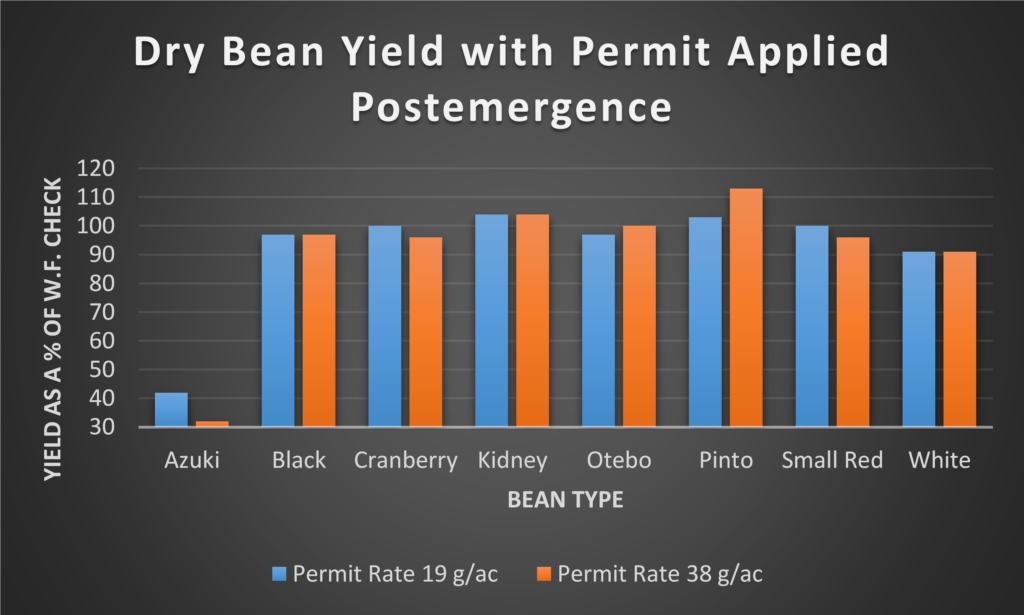Permit is registered in Ontario for use in dry common beans as a preplant incorporated (PPI), preemergence (PRE) or postemergence (POST) treatment for the control of broadleaf weeds and yellow nutsedge. Such flexibility in application timing is unique to Permit. Currently there are no other herbicides for use in dry beans with such a wide window of application. Crop tolerance can vary with herbicides depending on application timing and bean type. Knowledge of dry bean tolerance to herbicides may influence the growers’ decision on herbicide application timing. Growers can weigh out the risks with the benefits of different herbicides, balancing crop tolerance with field specific weed control needs.
Permit and Pursuit are both Group 2 herbicides. Pursuit is limited to PPI or PRE applications. Dry bean sensitivity to Pursuit has been identified and level of injury with soil applications depends on product rate and the dry bean market class. Pursuit at labeled rates is too injurious for postemergence use.
Permit can be applied PPI, PRE and POST. With such a wide range of application timing it is important to understand the tolerance of dry bean to Permit at all application timings and across a range of dry bean market classes.
Evaluations
Five dry bean herbicide tolerance trials were conducted between 2007 and 2008 at the Huron Research Station, Ridgetown Campus and Harrow (AAFC) to evaluate Permit applied PPI, PRE and POST on eight dry common bean market classes (black, cranberry, kidney, otebo, pink, pinto, small red and white). Rates evaluated were 19 g/ac (1X) and 38 g/ac (2X). Postemergence applications were made at V2-V3 plant growth stage with Agral 90. Assessments included crop injury, plant biomass, bean height and yield.
Results – PPI, PRE and POST (2007-2008)
Crop injury symptoms from Permit in dry bean include chlorosis, reduced growth, necrosis and damage or death of the growing point. Symptoms are more pronounced with POST applications. Dry bean tolerance to soil applied applications (PPI & PRE) of Permit was excellent with less than 2 percent injury across both rates and all eight bean market classes one week after application (1 WAA). POST applications resulted in injury ratings of less than 4 percent at 19 g/ac and over 8 percent at the 38 g/ac rate. Injury across all market classes and rates was transient with no commercially significant decrease in yield. Kidney, otebo and white bean were the most sensitive to POST applications of Permit.

Results – POST (2009-2010)
Four additional trials were conducted between 2009 and 2010 to confirm the tolerance of dry bean to Permit applied POST. In these trials, pink beans were excluded from the eight bean types and azuki beans were added. Rates evaluated were 19 g/ac (1X) and 38 g/ac (2X). Application was made at V2-V3 plant growth stage with Agral 90. Assessments included crop injury, plant biomass, bean height and yield.
Injury ratings one week after application (1 WAA) ranged from 7 to 13 percent in black, cranberry, kidney, otebo, pinto, small red and white bean. This injury was transient and at 4 WAA had declined to 2 percent or less at the 2X rate with no commercially significant reduction in yield.
Injury in azuki bean was significant with up to 51 percent visual injury 1 WAA. At 4 WAA injury was 65 percent at the 1X rate and 81 percent at the 2X rate. Azuki bean yield losses were 58 percent at the 1X rate and 68 percent at the 2X rate compared to the control.

Conclusions
Permit can safely be applied PPI, PRE or POST in dry common bean. Recent research suggests that soil applied applications of Permit can safely be used in azuki bean. Permit should not be applied POST in azuki bean. Always check and follow label directions. Permit is an excellent management tool for dry bean growers providing flexibility for different cropping systems and focused weed management to best suit grower needs.
For further information please contact Peter Sikkema (psikkema@uoguelph.ca) or Todd Cowan (tcowan@uoguelph.ca)
This article was written by Todd Cowan and Peter Sikkema.